Capitol Hill, Seattle
Capitol Hill | |
|---|---|
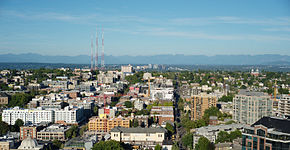 Capitol Hill as seen from 9th Avenue andPine Street,looking east | |
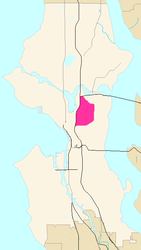 Capitol Hill's location in Seattle | |
| Coordinates:47°37′N122°19′W/ 47.617°N 122.317°W | |
| Country | United States |
| State | Washington |
| City | Seattle |
| City Council | District 3 |
| Neighborhood Council | East District |
| Police District | East Precinct, E1-3 |
| Established[1] | February 4, 1886(annexation by Seattle) |
| Founded by | James A. Moore |
| Named for | Potential state capitol |
| Area | |
| • Total | 1.64 sq mi (4.2 km2) |
| Population | |
| • Total | 32,144 |
| • Density | 20,000/sq mi (7,600/km2) |
| ZIP code | 98102, 98112, 98122 |
Capitol Hillis a densely populated residential district inSeattle,Washington,United States. It is immediately east ofDowntown Seattleand north ofFirst Hill.The neighborhood is one of the city's most popularnightlifeand entertainment districts and is home to a historicgay villageand vibrantcounterculturecommunity.
History[edit]

In the early 1900s Capitol Hill was known as 'Broadway Hill' after the neighborhood's main thoroughfare.[3]The origin of its current name is disputed. James A. Moore, thereal estatedeveloper whoplattedmuch of the area, reportedly gave it the name in the hope that theWashington State Capitolwould move to Seattle fromOlympia.Another story claims that Moore named it after theCapitol Hillneighborhood ofDenver, Colorado,his wife's hometown. According to author Jacqueline Williams, both stories are likely true.[4]The neighborhood was frequently referred to as Catholic Hill up until the 1980s due to its largeCatholicpopulation.[5]
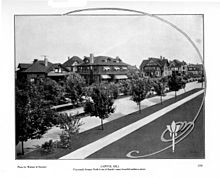
Capitol Hill is home to some of Seattle's wealthiest neighborhoods, including "Millionaire's Row" along 14th Avenue E. south of Volunteer Park (family residences on tree-lined streets) and theHarvard-Belmont Landmark District.The neighborhood is home to many distinguished apartment houses, including several byFred Anhalt,as well as a few survivingClassical Revivalcomplexes such as theBlackstone Apartments.The neighborhood's architecture did not fare so well in the post-World War IIperiod; architectVictor Steinbrueckwrote in 1962 of the "tremendous growth of less-than-luxury apartments" that at first "appear to be consistent with the clean, direct approach associated with contemporary architecture" but whose "open outdoor corridors" totally defeat their "large 'view' windows" by giving occupants no privacy if they leave their blinds open to enjoy the view. He added, "most tenants close their blinds and look for another apartment when their lease runs out."[6]


During theGeorge Floyd protestsof 2020, Cal Anderson Park and surrounding blocks along Pike and Pine Streets near the SPD East Precinct were occupied by protesters and declared theCapitol Hill Autonomous Zone(CHAZ).[7][8]
Geography[edit]
Capitol Hill is situated on a steep hill just east of the city's downtown central business district. It is bounded byInterstate 5(I-5) to the west (beyond which areDowntown,Cascade,andEastlake); to the north byState Route 520andInterlaken Park(beyond which are Portage Bay andMontlake); to the south by E. Pike and E. Madison Streets (beyond which areFirst Hilland theCentral District); and to the east by 23rd and 24th Avenues E. (beyond which isMadison Valley).
Capitol Hill's main thoroughfare is Broadway, the commercial heart of the district. Other major streets in the area are 10th, 12th, 15th, and 19th Avenues, all running north–south, and E. Pine, E. Pike, E. John, E. Thomas, and E. Aloha Streets and E. Olive Way, running east–west. Of these streets, large portions ofE. Pike Street,E. Pine Street,Broadway,15th Avenue, and E. Olive Way are lined almost continuously with street-level retail. The Pike-Pine corridor (the area between Pike and Pine streets) from Boren Avenue through 15th Street is another main thoroughfare in Capitol Hill, full of coffee shops, bars, restaurants, and other food and music businesses. The neighborhood is largely characterized by mid-rise buildings occupied by an eclectic mix of businesses.
The highest point on Capitol Hill, at 444.5 feet (135.5 m) above sea level, is inVolunteer Park,adjacent to thewater tower.Capitol Hill is also the location of half of Seattle's 12 steepest streetgrades:21% on E. Roy Street between 25th and 26th Avenues E. (eastern slope), 19% on E. Boston Street between Harvard Avenue E. and Broadway E. (western slope) and on E. Ward Street between 25th and 26th Avenues E. (eastern slope), and 18% on E. Highland Drive between 24th and 25th Avenues E. (eastern slope), on E. Lee Street between 24th and 25th Avenues E. (eastern slope), and on E. Roy Street between Melrose and Bellevue Avenues E. (western slope).

Transportation[edit]
TheLink light railsystem'sCapitol Hill stationis served by the1 Lineand opened in March 2016 as part of theUniversity Linkextension. The 1 Line connects the neighborhood to theUniversity of Washingtoncampus to the north, andDowntown Seattleto the south.[9]The station is located along Broadway south of John Street and Olive Way.[10]
TheFirst Hill Streetcarline, which opened in January 2016, terminates in the neighborhood on Broadway at Denny Way, just south of the Link light rail station. Capitol Hill was previously served bycity-run streetcarsuntil 1940.[11]
Bus transit service to and within Capitol Hill is provided byKing County Metro,including routes 10, 12, 43 and 49 of theSeattle trolleybus system.The City of Seattle and King County Metro are under construction on the Rapid Ride G bus line along Madison Street, connecting from downtown Seattle, through First Hill, then Capitol Hill, and beyond toMadison ValleyandMadison Park.The bus line will include 6-minute headways during peak times, and center-boarding stations between 9th and 13th avenues.[12]
Culture[edit]
Arts and entertainment[edit]
Capitol Hill has a reputation as a bastion of musical culture in Seattle and is the neighborhood most closely associated with thegrungescene from the early 1990s, although most of the best-known music venues of that era were actually located slightly outside the neighborhood. The music scene has transformed since those days and now a variety of genres (electronica, rock, punk, folk, salsa, hip hop and trance) are represented.
The neighborhood figures prominently in nightlife and entertainment, with many bars hosting live music and with numerousfringe theatres.Most of the Hill's major thoroughfares are dotted withcoffeehouses,tavernsandbars,and residences cover the gamut from modestmotel-like studio apartment buildings to some of the city's most historicmansions,with the two types sometimes shoulder-to-shoulder.
Capitol Hill is also home to two of the city's best-known movie theaters, both of which are part of theLandmark Theatreschain. Both theaters are architectural conversions of private meeting halls: theHarvard Exit(now closed permanently) in the former home of the Woman's Century Club (converted in the early 1970s) and the Egyptian Theatre, in a formerMasoniclodge (converted in the mid-1980s). There is also Seattle's onlycinematheque,the Northwest Film Forum, which in addition to screening films, teaches classes on filmmaking and produces film alongside Seattle's burgeoning filmmaking community. These theaters respectively host showings for theSeattle International Film Festival(SIFF) and theSeattle Lesbian & Gay Film Festivalevery year. The Broadway Performance Hall, located on the campus ofSeattle Central College(SCC), also hosts a variety of lectures, performances, and films. The cast ofMTV'sReal World Seattle: Bad Bloodlived in and were filmed in Capitol Hill during 2016.
Since 1997, Capitol Hill has hosted theCapitol Hill Block Partyannually in late July, an outdoor music festival that occurs on Pike Street between Broadway and 12th Ave and Union and Pine Street.
A "mystery soda machine",dispensing unusual drink flavors, was present in Capitol Hill from the late 1990s to 2018. Allison Williams ofSeattle Metnoted several years after the machine was removed, that the neighborhood of Capitol Hill now has a morecorporate cultureand may no longer be "weird enough for a persistent enigma."[13]
Coffeehouses[edit]
Besides the large Seattle-based chains—Starbucks,Seattle's Best Coffee(now owned by Starbucks), andTully's Coffee—Capitol Hill has been home to some of the city's most prominent locally owned coffeehouses. David Schomer'sEspresso Vivaceon Broadway is credited as the birthplace of artisanalcoffee cultureandlatte artin Seattle and the United States as a whole.[14]The neighborhood is also considered a test market for coffeehouses by Starbucks Corporation, which placed twostealth Starbucksstores on Capitol Hill in 2009 and 2011 that were later closed by 2019.[15]
LGBTQ community[edit]
This section'stone or style may not reflect theencyclopedic toneused on Wikipedia.(July 2020) |
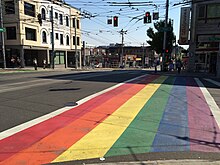
A bourgeoning counterculture community on Capitol Hill in the mid-20th century became a magnet for LGBTQ people seeking community acceptance at a time when the city's earlier gay capital inDowntown Seattle's (notoriously rowdy)Pioneer Squarewas in decline.[16]As a result, large-scale gay residential settlement of Capitol Hill began in the early 1960s, and the district continues to be home to a sizable number of LGBTQ people, making Capitol Hill Seattle's "gayborhood".[17]
The roots of the LGBTQ community on Capitol Hill can be traced to a change in the demographics and culture of the city as a whole in the 1950s and 1960s. LGBTQ Seattleites had long congregated in Pioneer Square, often interchangeably termed "Skid Road," and had built up a community in establishments such as the Double Header, the Casino, and the Garden of Allah (just north of the neighborhood). When the neighborhood, which houses many notable works of Victorian and Edwardian architecture, was targeted for urban renewal (and perhaps even prior), theSeattle Police Departmentengaged in extortion, allowing illegal homosexual practices and cross-dressing to continue only in bars which paid them off. The payoffs did not always guarantee security, and in 1966, citing alarm over the city's widespread image as a bastion of gay culture and tolerance, SPD planned a major house-cleaning of the gay bars in Pioneer Square.[18][19]The gay community then began to migrate out of Downtown Seattle, which was accelerated by the opening of theKingdomeand redevelopment of the neighborhood for sports-friendly uses in the 1970s.[20]
The rise of American counterculture on the west coast took place during the same period. Although theUniversity District,home to sites such as theAve,theUniversity of Washington,Parrington Lawn or "Hippie Hill", theLast Exit On Brooklyncoffeehouse, and theBlue Moon Tavern,was the primary hub of 1960s counterculture in Seattle, Capitol Hill also experienced a very noticeable influx of artistic and bohemian life. Largely driven by low rent from "white flight" in the steadily disappearing "auto row" of Capitol Hill's Pike-Pine Corridor neighborhood, LGBTQ Seattleites began to build the foundations of a community of their own deep in the structure of this evolving neighborhood.[21]
After the Elite Tavern, the first gay bar on Broadway, opened in the 1950s, the LGBTQ community on the Hill began to grow parallel to its decline in Pioneer Square. By the late 1960s, Capitol Hill was primed to become the local home base of thegay liberationmovement and community throughout the decade following theStonewall riotsof 1969 in New York City.[18]
Capitol Hill was the birthplace of many notable LGBTQ organizations during the first 25 years of the gay rights movement. In July 1969, only a few days after the Stonewall riots, the Dorian Society opened Dorian House in Capitol Hill's Hilltop neighborhood, a locale which soon became an important hub of LGBTQ youth outreach. Now called Seattle Counseling Service, it was the first mental health organization in the United States specializing in affirming treatment of ostracized LGBTQ youth. In 1974, the Gay Community Center opened in the Hilltop area. In 1991, Lambert House LGBTQ youth community center, also in the Hilltop, opened its doors and became a model organization for queer youth outreach. After moving from Downtown in 1982, Seattle's officialgay prideparades took place on Capitol Hill for several decades, and the annual festival continues to hold block parties on the Hill.[21]In the 1980s, the Northwest AIDS Foundation, the Chicken Soup Brigade, and the Evergreen Health Advocates formed to combat the growingHIV/AIDS epidemic,and eventually merged to become theLifelong AIDS Alliance.[22][non-primary source needed]
The gay and bisexual male community on Capitol Hill was the epicenter of the HIV/AIDS epidemic in the region.[17]In addition to the organizations that would become Lifelong, more services were created to serve the growing health needs of the gay community in the 1990s, including Pike-Pine'sGay City Health Project,formed in 1995.[23][non-primary source needed]Among the deceased in 1995 was Washington's first openly-gay legislator,Cal Anderson,who was the state legislative representative for Capitol Hill and the University District. In remembrance of Anderson's legacy,Lincoln Reservoir Park,the mainOlmstediancenterpiece to the urban landscape of the Broadway, Pike-Pine, and Hilltop neighborhoods which form the core of Capitol Hill's LGBTQ community, was renamed in his honor.[21]
During Pride week of 2015, eleven permanent rainbow crosswalks were painted in the Capitol Hill portion of the Pike-Pine corridor.[24]In 2020, the plaza atop Capitol Hill light rail station adjacent to Cal Anderson Park became home to theAIDS Memorial Pathway,a permanent outdoor public art gallery commemorating victims of the HIV/AIDS epidemic.[25]In 2019, the block of E Denny Way at the light rail station that connects Broadway to Cal Anderson Park was renamed E Barbara Bailey Way, after a notable small business owner and LGBTQ rights activist.[26]
In 1993, the oldest gay bar on Broadway, the Elite Tavern, was bombed by neo-Nazis.[21]Capitol Hill has become the target of an increasing number of anti-LGBTQ hate crimes in the early 21st century.[27]The increased gentrification of the neighborhood by the end of the 20th century led to an outward migration of the LGBTQ community to other areas of the city and surrounding metropolitan area.[20]From 2000 to 2012, the share of same-sex couple households on Capitol Hill declined by 23 percent, while it increased by 52 percent citywide.[28]
Landmarks and institutions[edit]

Registered Historic Placeson Capitol Hill include theHarvard-Belmont Landmark District,in which is located the original building of theCornish College of the Arts;Volunteer Park,in which are theSeattle Asian Art MuseumandVolunteer Park Conservatory;andThe Northwest School.
In addition to Volunteer Park, parks on Capitol Hill includeCal Anderson Park,Louisa Boren Park,Interlaken Park,Roanoke Park,Pendleton Miller Park, andThomas Street Park.Lake View Cemetery,containing the graves ofBruce Leeand his sonBrandon Lee,lies directly north of Volunteer Park, and theGrand Army of the Republic Cemeteryis further north.
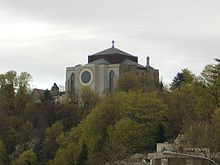
Also on the Hill areThe Northwest School,Seattle Academy of Arts and Sciences,St. Joseph School,Holy Names Academy,Seattle Hebrew Academy,Seattle Preparatory School,Seattle University,Seattle Central Community College,andSt. Mark's Episcopal Cathedral.Additionally,Seattle Universityis located south of Madison Street, and is considered to be either in Capitol Hill orFirst Hill.
The oldestAfrican-American churchin Seattle is located on 14th Avenue, between E Pike and E Pine streets. The First African Methodist Episcopal Church was originally incorporated in 1891 as the Jones Street Church (when 14th Avenue was called Jones Street). The church was constructed in 1912, replacing the large house where congregations previously met, on the same site. The church structure was designated as a Seattle landmark in 1984.[29]
TheFirst Methodist Protestant Church of Seattle,listed on theNational Register of Historic Places,was remodeled and is now[when?]occupied by a design and marketing firm.
There is one Jewish synagogue near Capitol Hill.Temple De Hirsch Sinai,whose Alhadeff Sanctuary was designed byB. Marcus Priteca,among others, is just south of Madison Street, placing it technically in theCentral District.[30]
In 2021, St Patrick's church on East Edgar Street was named as one of three Catholic churches facing closure in a reorganization plan by theArchdiocese of Seattle.[31]
References[edit]
- ^"Seattle Annexation Map".Archived fromthe originalon June 14, 2012.
- ^abc"Based on King County Census Tracts 64, 65, 74.01, 74.02, 75, 76, and 84"(PDF).
- ^"Seattle Neighborhoods: Capitol Hill, Part 2 -- Thumbnail History".www.historylink.org.RetrievedNovember 14,2022.
- ^Dorpat, Paul(May 7, 2001)."Seattle Neighborhoods: Capitol Hill, Part 1 — Thumbnail History".HistoryLink.RetrievedJuly 5,2020.
- ^Atkins, Gary (2003).Gay Seattle: Stories of Exile and Belonging….Seattle:University of Washington Press.pp. 272–292.ISBN978-0-295-98298-4.
- ^Victor Steinbrueck,Seattle Cityscape,University of Washington Press,Seattle, 1962, p. 73.
- ^"Protesters Establish Autonomous Zone Around Seattle PD Building as Police Retreat".Democracy Now!.June 9, 2020.RetrievedJune 9,2020.
- ^Staff, MyNorthWest (June 9, 2020)."Live updates: Protesters establish 'Free Capitol Hill' near East Precinct".MyNorthwest.KIRO-FM.RetrievedJuly 5,2020.
- ^Lee, Jessica (March 18, 2017)."Light-rail ridership soars in year after UW, Capitol Hill stations open".The Seattle Times.RetrievedMarch 25,2023.
- ^Lindblom, Mike (March 14, 2016)."Take a look inside Capitol Hill's long-awaited light-rail station".The Seattle Times.RetrievedMarch 25,2023.
- ^Deshais, Nicholas (September 25, 2019)."After a 76-year absence, streetcars return to Seattle's First Hill on January 23, 2016".HistoryLink.RetrievedMarch 25,2023.
- ^"Madison - RapidRide G Line: Downtown Seattle to First Hill to Madison Valley".Seattle Department of Transportation.RetrievedMarch 4,2023.
- ^Williams, Allison (August 28, 2023)."Whatever happened to Capitol Hill's mystery Coke machine?".Seattle Met.Archivedfrom the original on October 10, 2023.
- ^Romano, Tricia (October 22, 2015)."Vivace's David Schomer — not Starbucks — 'made coffee huge in Seattle'".The Seattle Times.RetrievedJuly 5,2020.
- ^Millman, Zosha (February 18, 2019)."Starbucks closes final Capitol Hill non-Starbucks coffee house".Seattle Post-Intelligencer.RetrievedJuly 5,2020.
- ^McKenna, Kevin; Aguirre, Michael."A Brief History of LGBTQ Activism in Seattle".RetrievedJuly 4,2020.
- ^abHill, Chrystie (November 28, 2003)."Queer History in Seattle, Part 2: After Stonewall".HistoryLink.RetrievedJuly 5,2020.
- ^abHill, Chrystie (April 12, 2003)."Queer History in Seattle, Part 1: to 1967".HistoryLink.RetrievedJuly 5,2020.
- ^Crowley, Walt(June 20, 2001)."Seattle Neighborhoods: Pioneer Square — Thumbnail History".HistoryLink.RetrievedJuly 5,2020.
- ^abKiley, Brendan (June 28, 2024)."How Capitol Hill became Seattle's gayborhood".The Seattle Times.RetrievedJuly 1,2024.
- ^abcdCaldbick, John (June 3, 2011)."Seattle Neighborhoods: Capitol Hill, Part 2 — Thumbnail History".HistoryLink.RetrievedJuly 5,2020.
- ^"About".Lifelong AIDS Alliance.RetrievedJuly 5,2020.
- ^"About Gay City".RetrievedJuly 5,2020.
- ^Raghavendran, Beena (June 23, 2015)."Colorful crosswalks celebrate gay pride in Seattle".The Seattle Times.RetrievedJuly 5,2020.
- ^Doughton, Sandi(December 20, 2019)."The AIDS Memorial Pathway is getting closer to reality".The Seattle Times.RetrievedJuly 5,2020.
- ^Takahama, Elise (June 26, 2019)."Capitol Hill street may be named in honor of LGBTQ+ rights champion Barbara Bailey".The Seattle Times.RetrievedJuly 5,2020.
- ^"Inside Seattle's continued rise in hate crime reports, Capitol Hill and borders of 'racially diverse' neighborhoods are hot spots".Capitol Hill Seattle Blog.May 13, 2019.RetrievedJuly 5,2020.
- ^Balk, Gene (July 31, 2014)."Map: Is Seattle's 'gayborhood' vanishing?".The Seattle Times.RetrievedJuly 1,2024.
- ^Henry, Mary T. (December 31, 1998)."First African Methodist Episcopal Church (Seattle)".HistoryLink.RetrievedAugust 17,2011.
- ^Temple De Hirsch Sinai
- ^"Seattle Archdiocese plan to close churches stirs sadness, anger and resistance".Seattle Times.August 7, 2021.RetrievedAugust 8,2021.
- Kathryn McGrath, "Clubless in Seattle",University of WashingtonDailyOnline, October 3, 1996: on the Teen Dance Ordinance.
External links[edit]
- Heather MacIntosh,Preservation in Capitol Hill,Preservation Seattle(online publication ofHistoric Seattle), February 2004
- The Seattle Photograph Collection, Capitol Hill- University of Washington Digital Collection
